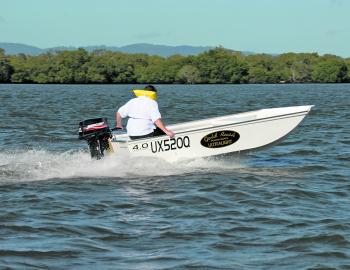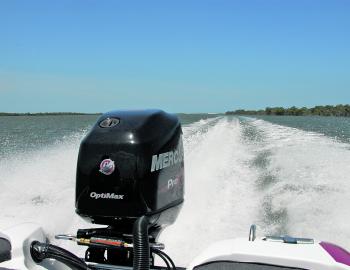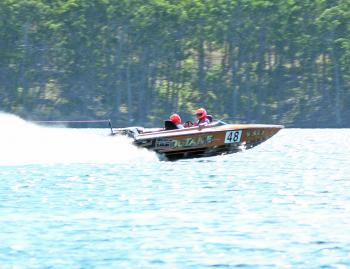It’s a strange thing about human thinking: bigger seems to be better and faster seems to be more fun! Maybe it harks back to primitive times, when brute strength and fleetness of foot ensured survival.
Things have certainly changed today with bigger, better, faster and more fun are morphing into a penchant for flaunting achievements and enjoying speed. Where we can enjoy it, that is!
That said, we live in a very measured society where rules are made for a common good and checks and balances are designed to ensure the safety of all of us. Whether motoring or boating, there are certain things we just need to comply with.
Along with posted speed limits and other boating rules, there are certain stipulations regarding capacity and powering of small craft. In fact, those designed to be fitted with a combustion engine are fitted with a metal Australian Builders Plate affixed to a prescribed location within the boat. The ABP sets out vital compliance information such as number of passengers, combined weights of persons aboard along with engine horse power ratings, maximum engine weight, with an overall stipulation of maximum engine and passengers weight all up.
These specs are not designed as rough guidelines to work around: they are there to ensure that the boat strictly complies with AS179, Australian Standards for Small Craft. Where the plate shows that a maximum engine is, say, 40 or 50hp, or if the weight, for example, is set at 120 kg, then those are the limits.
Most manufacturers tend to adequately power their boats without overdoing things and on this latter topic, I’m on record as not being a great fan of maximum powered small boats, as smaller craft – under around 4.5min length – can be twitchy when there’s maximum power fitted.
That said, so long as an engine is within limits and has been fitted by a qualified marine craftsman correct weight distribution, used in conjunction with judicious use of the throttle, things can be kept on the level, so to speak. And make no mistake, correct engine fitting is a science, not something to be done at home as an afterthought.
I recently saw an example of a small craft, under 4.3m, which was far overpowered or maybe set up with a badly fitted engine. It was a scenario that could have so easily ended in tragedy, but luckily did not.
I was not close enough to ascertain the exact engine horse power, but the engine sure looked very, very large on the back of that small tinny, which meant that the bow high attitude was caused by the outboard being either too heavy for the craft or grossly over powering it. My suspicions are that it was a combination of both circumstances.
The craft was cruising along at around 8 knots with so much of the bow out of the water that the skipper, and sole occupant, had to stand, hand on tiller to actually see where he or she was going. That was the first part of my disbelief, but more was to follow.
On the throttle being opened, the craft leapt upwards out of the water and the skipper departed, exit stage left. Fortunately, so very fortunately, as the skipper departed the rig the throttle must have flicked closed and although the craft kept moving in the traditional circle, it was quite slow, so a passing boat firstly picked up the skipper from the drink then they managed to corral the runaway rig and tame it. Once the skipper was back aboard, the craft proceeded on it’s way at a reduced speed, but with the bow still very high nonetheless.
This is an extreme example, but there’s a few lessons here. Firstly, never drive a boat that has either been so overpowered or overweighted in the stern to the extent that the bow is so high there’s no forward visibility available, even if engine ratings are within specified limits!
The day the rig enters the water is the day to check things out and if the craft exhibits these sorts of traits, it must go straight back to the dealer or seller and have things rectified or changed. Most small craft will lift their bow to commence planing, that’s a given, but once the power comes on line the bow should return to a flat condition. That’s also a given.
Remember that in the overpowering or overweighting situation, there will be no insurance forthcoming in the event of a claim. Insurance companies keep a careful and exact record of all emails, phone calls and paper work forwarded when insurance cover is requested, so if there is a discrepancy between engine specifications quoted on the initial request for insurance and that noted by a claims assessor, the company walks.
Also, if injury or worse occurs, it becomes a matter for police investigation and action. Remember, the skipper is responsible at all times. It’s different to driving on the roads, where blame can be apportioned.
It’s food for thought, but well worth remembering when it’s time to purchase a new rig or repower an old one. Stick to the guide lines, and stay safe.
Reads: 11743
Here we see a small craft lifting it’s bow to plane. Within a few boat lengths the craft returned to a normal, flat attitude.

Power is fine if the rig is designed for it, as is the case with bass boats.

A ski race craft in action: these hulls are powered to their maximum.

Although it may seem overpowered, the hulls are specifically designed to take as much power as possible.




